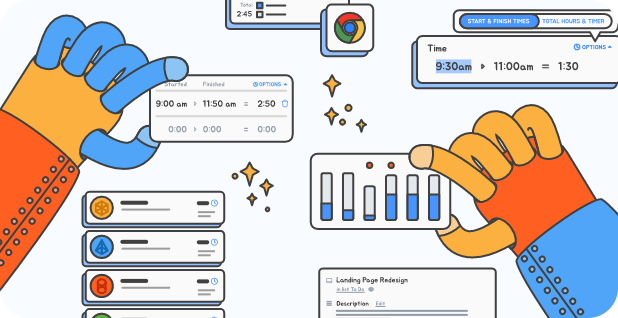Why Sales Teams Should Track Their Time
Time Tracking In Sales Improves Key Performance Metrics
Every sales leader can recite pipeline coverage ratios or forecast accuracy to two decimal places, yet surprisingly few know how their account executives actually spend the eight-plus hours between the morning stand-up and the evening sign-off. That silence around “where the day went” is not just a harmless oversight; it is a silent tax on every key performance metric that matters. Multiple studies now confirm that modern sellers devote barely a third—and sometimes less than a quarter—of the working week to genuine, buyer-facing conversations. Salesforce’s own research, recapped by Clari, shows the selling slice to be as low as 28% to 34% of total hours. Additional time-and-motion analyses, including a long-running study by productivity firm Pace, arrive at nearly identical numbers, putting the median at 26%. Put differently, if your team “works” a forty-hour week, only eleven of those hours actively move revenue forward, and you pay for the other twenty-nine just to keep the lights on.
Those lost hours accumulate into eye-watering opportunity costs. Forbes recently highlighted that apparently innocuous administrative detours, task switching, and context-free meetings compound into a multi-trillion-dollar phenomenon now labelled “revenue leakage.” Clari’s 2024 Revenue Leak Report sharpened the point: 61 % of companies missed their 2023 targets, and survey respondents blamed much of the gap on untracked micro-inefficiencies hidden inside their sales cycle. In a climate where growth capital is scarce and churn lurks behind every renewal, reclaiming those invisible minutes is no mere housekeeping project; it is a strategic imperative.
Time Tracking is More than Punch Clocks and Spreadsheets
Time tracking, in this context, does not mean forcing quota-carrying professionals to punch an antiquated time clock or fill out soul-crushing spreadsheets at day’s end. Modern practice marries discrete, unobtrusive data capture with contextual tagging. Calendar integrations record the actual duration of discovery calls and demos; CRM plug-ins timestamp each logged activity; background timers tie document edits to specific opportunities, and AI services silently classify chunks of effort as prospecting, negotiation, proposal drafting, or routine admin. Reps do not “clock in”; they work while the system watches, then they correct any mis-tagged fragments with a couple of keystrokes.
What emerges is a GPS-style trace of the workweek, overlaid on your revenue model. Just as Waze turns raw co-ordinates into a predicted arrival time, an intelligent time-tracking software converts dispersed effort into leading indicators of quota attainment, cycle velocity, and pipeline health. When that behavioural telemetry sits inside the same dashboard as bookings and win rates, managers no longer coach from gut instinct: they operate with a diagnostic instrument as tangible as an MRI scan.
The Hidden Cost of Unmeasured Minutes
Why do unmeasured minutes hurt so badly? First, they misprice labour. A company that budgets head-count assuming forty productive hours effectively overestimates the selling capacity of each rep by at least fifty per cent. Second, opaque calendars disguise structural bottlenecks. Suppose engineering approval for a bespoke quote burns three days in back-and-forth emails; unless the time stamp is visible, leadership may assume the seller simply “moves slowly.” Finally, the absence of a time ledger encourages heroic improvisation—late-night email blitzes, weekend proposal builds—activities that mask systemic waste with individual overwork.
Contrast that with teams that illuminate every hour. When account executives see their own “selling-time ratio” staring back at them—alongside peers whose numbers run ten points higher—friendly competition kicks in. They prune meetings, script common objections, automate paperwork, and ask operations to template the legal boilerplate that once consumed half a Tuesday. Each reclaimed half-hour compounds into a noticeably fatter pipeline within a single fiscal quarter.
How Better Time Data Lifts Every Core Metric
Activity efficienct and selling-time ratio: The most immediate improvement appears in the share of the week devoted to live prospect or customer interaction. When the baseline is 28 %, even modest gains matter. Teams that expose the ratio routinely push past 50% by the second full quarter because waste cannot hide and unproductive rituals lose airtime.
Lead-response speed: Ask any demand-gen manager - the odds of connecting with an inbound lead plummet minute by minute. Yet many teams discover, after turning on time stamps, that qualified leads sit unattended for hours while reps wrestle with CRM hygiene. Once latency becomes a line item, sales ops can automate enrichment, or marketing can pipe contacts directly into the dialler. It is not uncommon to see average first-touch time shrink from two hours to under twenty minutes, multiplying early-stage conversion rate.
Sales-cycle length: Cycle time, the heartbeat of revenue velocity, is essentially the sum of all micro-delays between stages. If your proposals spend seventy-two hours waiting for formatting help, that lag adds three full days to every deal—days during which competitors are free to strike. Time tracking highlights those dead zones, empowering managers to outsource formatting, adopt template software, or pre-approve discount tiers. Shortened cycles free capacity: the same head-count can now shepherd more opportunities through the funnel each quarter.
Win rate and conversion: Nearly every closed-won analysis uncovers a counter-intuitive insight: successful deals usually receive more focused time early on, not less overall time. A thorough, 18-minute discovery call reveals pain points that a hurried five-minute chat misses, ultimately yielding a richer value narrative and a stronger business case. When managers can correlate minutes spent in discovery with conversion probability, coaching becomes surgical: “Invest at least fifteen minutes uncovering impact, because deals below that threshold convert eight points worse.”
Average deal size: Deeper account research, multi-threading outreach, and tailored ROI modelling all demand uninterrupted blocks of concentration. Once those blocks are tagged and measured, leadership can show, with data, that reps who defend ninety minutes of “deal strategy” each week close packages twenty-five per cent larger. The implication becomes hard to ignore, and sellers voluntarily ring-fence that thinking time.
Forecast accuracy: Traditional forecast roll-ups rely on stage definitions and subjective rep confidence. Introduce time investment per deal and probability weightings improve. An opportunity with six collective hours of buyer engagement is materially healthier than a similarly staged but barely touched record. Revenue-ops teams that integrate time-intensity scores report markedly tighter forecast variance.
Translating Insight Into Action: an Implementation Blueprint
- Start with a baseline and a clear “why.” Before toggling any timers, pull the last three months of cycle metrics. Frame the project not as surveillance but as a shared experiment to protect seller focus and raise commissions.
- Pilot with a micro-cohort. Choose one enterprise AE, one mid-market AE, and a business-development rep. Equip them with a time tracker that allows them to tag Zoom calls, email threads, and document edits. Collect qualitative feedback for a full sprint. The trio’s early wins—“I gained six net selling hours per week”—become your internal marketing.
- Automate first, annotate second. Habit formation crumbles if sellers must manually punch timers in perpetuity. Modern systems apply natural-language rules (“any calendar event containing ‘demo’ equals Stage 2 meeting”) and let reps correct the occasional mis-classification rather than log every task.
- Surface insights quickly. Within the first fortnight, publish a lightweight dashboard: selling-time ratio, lead-response median, and hours lost to admin. Visibility is the nudge; conversation around the numbers drives behaviour change.
- Iterate and celebrate. You will discover redundant categories (“internal sync about the internal sync”) and overlooked ones (“account mapping”). Tune the taxonomy monthly. Publicly recognise the reps who reclaimed the most customer-facing minutes; positive reinforcement consolidates the habit.
Addressing the Elephant in the Salesforce: Resistance and Privacy
Sellers, especially veterans, may bristle at the idea of their calendar becoming a management artefact. Three commitments defuse the tension:
- Reciprocity. Leaders track their own hours, proving the data is for process improvement, not micromanagement.
- Value exchange. Time metrics feed back into personalised coaching, territory redesign, or resource allocation. Reps see a clear payoff—higher win rates and fatter pay-checks.
- Granular privacy controls. The goal is to know that forty minutes went to proposal drafting, not to inspect the exact document in real time. Systems can store aggregated categories, satisfying legal and ethical expectations.
Once the data begins to boost commissions, the scepticism fades. Sellers who initially clicked “pause tracking” during lunch soon flip the switch back to capture genuine prospecting blocks because they want credit for every ounce of hustle.
The Road Ahead: Predictive Calendars and Autonomous Selling Minutes
Time tracking today echoes early CRM adoption a generation ago—initially a compliance burden, eventually a strategic edge. The next wave pairs real-time behavioural data with generative AI. Calendar bots already recommend the optimal follow-up window based on a prospect’s historical reply cadence. Emerging systems will soon create draft proposals, surface unaddressed objections buried in call transcripts, and re-sequence multithreaded outreach—all in order to return deeper blocks of uninterrupted selling time to humans. At that point, “time tracked” morphs into “time predicted,” and the competitive moat around disciplined teams widens even further.
Make Time Your Loudest KPI
Revenue leaders obsess over leading indicators—calls made, emails sent, demos booked—yet the common denominator across them all is time. You can hire seasoned closers, deploy AI diallers, and pump the funnel with triple the MQLs, but if a majority of the working week still leaks into administrative quicksand, growth will stall. Conversely, bring the same rigour to the minutes that you bring to the numbers, and every downstream metric compounds in your favour: faster cycles, higher win rates, more accurate forecasts, and ultimately, bigger commission cheques that keep first-team players on your roster. The evidence is plain—documented by Forbes analysts, productivity researchers, and revenue-intelligence firms alike.
Track the clock, reclaim the day, and watch your key performance metrics rise with it.













